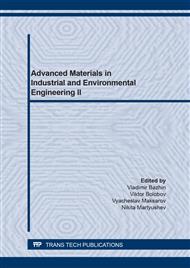p.75
p.87
p.94
p.101
p.109
p.117
p.124
p.132
p.139
Deactivation of Red Mud by Primary Aluminum Production Wastes
Abstract:
Current global environmental challenges and, above all, global warming associated with a change in the carbon balance in the atmosphere has led to the need for urgent and rapid search for ways to reduce greenhouse gas emissions into the atmosphere, which primarily include carbon dioxide as a by-product of human activity and technological progress. One of these ways is the creation of industries with a complete cycle of turnover of carbon dioxide. Aluminum is the most sought-after nonferrous metal in the world, but its production is not environmentally safe, so it constantly requires the development of knowledge-intensive technologies to improve the technological process of cleaning and disposal of production waste, primarily harmful emissions into the atmosphere. Another environmental problem related to aluminum production is the formation and accumulation in mud lagoon of huge amounts of so-called highly alkaline "red mud," which is a waste product of natural bauxite raw material processing into alumina - the feedstock for aluminum production. Commonly known resources and technological methods of neutralizing red mud and working with it as ore materials for further extraction of useful components are still not used because of their low productivity and cost-effectiveness. This article describes the negative impact of waste in the form of "red" mud and carbon dioxide of primary aluminum production on the environment. The results showed that thanks to carbonization of red mud using carbon dioxide, it is possible to achieve rapid curing and its compact formation for safer transportation and storage until further use. Strength tests of concrete samples filled with deactivated red mud were also carried out, which showed the prospects of using concrete with magnesia binder.
Info:
Periodical:
Pages:
109-116
Citation:
Online since:
July 2021
Authors:
Price:
Сopyright:
© 2021 Trans Tech Publications Ltd. All Rights Reserved
Share:
Citation:


